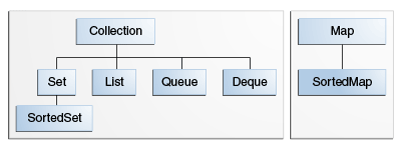A collection, as the name implies, is a group of objects. Java Collections framework consists of interfaces and classes that help work with different collection types such as lists, sets, maps, stacks and queues etc.
These ready-to-use collection classes solve lots of common problems where we need to deal with groups of homogeneous and heterogeneous objects. The common operations involved are add, remove, update, sort, search and more complex algorithms. These collection classes provide very transparent support for all such operations using Collections APIs.
1. Java Collections Hierarchy
The Collections framework is better understood with the help of core interfaces. The collections classes implement these interfaces and provide concrete functionalities.

1.1. Collection
Collection interface is at the root of the hierarchy. Collection interface provides all general purpose methods which all collections classes must support (or throw UnsupportedOperationException). It extends Iterable interface that adds support for iterating over collection elements using the “for-each loop” statement.
All other collection interfaces and classes (except Map) either extend or implement this interface. For example, List (indexed, ordered) and Set (sorted) interfaces implement this collection.
1.2. List
Lists represent an ordered collection of elements. Using lists, we can access elements by their integer index (position in the list), and search for elements in the list. index starts with 0, just like an array.
Some useful classes which implement List interface are – ArrayList, CopyOnWriteArrayList, LinkedList, Stack and Vector.
1.3. Set
Sets represent a collection of unique elements. Sets do not allow duplicate elements. Set interface does not provides a guarantee to return the elements in any predictable order; though some Set implementations store elements in their natural ordering and guarantee this order.
Some useful classes which implement Set interface are – ConcurrentSkipListSet, CopyOnWriteArraySet, EnumSet, HashSet, LinkedHashSet and TreeSet.
1.4. Map
The Map interface enables us to store data in key-value pairs (keys should be immutable). A Map cannot contain duplicate keys; each key can map to at most one value.
The Map interface provides three collection views, which allow a map’s contents to be viewed as a set of keys, collection of values, or set of key-value mappings. Some map implementations, like the TreeMap class, make specific guarantees as to their order; others, like the HashMap class, do not.
Some useful classes which implement Map interface are – ConcurrentHashMap, ConcurrentSkipListMap, EnumMap, HashMap, Hashtable, IdentityHashMap, LinkedHashMap, Properties, TreeMap and WeakHashMap.
1.5. Stack
The Java Stack interface represents a classical stack data structure, where elements can be pushed to last-in-first-out (LIFO) stack of objects. In Stack, we push an element to the top of the stack, and popped off from the top of the stack again later.
1.6. Queue
A queue data structure is intended to hold the elements (put by producer threads) prior to consumer thread(s) processing. Besides basic Collection operations, queues provide additional insertion, extraction, and inspection operations.
Queues typically, but do not necessarily, order elements in a FIFO (first-in-first-out) manner. One such exception is the priority queue which orders elements according to a supplied Comparator, or the elements’ natural ordering.
In general, queues do not support blocking insertion or retrieval operations. Blocking queue implementations classes implement BlockingQueue interface.
Some useful classes which implement Queue interface are – ArrayBlockingQueue, ArrayDeque, ConcurrentLinkedDeque, ConcurrentLinkedQueue, DelayQueue, LinkedBlockingDeque, LinkedBlockingQueue, LinkedList, LinkedTransferQueue, PriorityBlockingQueue, PriorityQueue and SynchronousQueue.
1.7. Deque
A double-ended queue (pronounced “deck“) that supports element insertion and removal at both ends. When a deque is used as a queue, FIFO (First-In-First-Out) behavior results. When a deque is used as a stack, LIFO (Last-In-First-Out) behavior results.
This interface should be used in preference to the legacy Stack class. When a deque is used as a stack, elements are pushed and popped from the beginning of the deque.
Some commonly known classes implementing this interface are ArrayDeque, ConcurrentLinkedDeque, LinkedBlockingDeque and LinkedList.
2. Java Collections and Generics
By purpose, generics provide type safety. It detects the incompatible types (in method arguments) and prevents ClassCastException in runtime. We can also define a collection class in Java collections to store only a certain type of object. All other types should be disallowed. This is done via generics.
The first two add() methods are allowed in the given example. The third one will not compile and will give error – “The method put(Integer, String) in the type HashMap<Integer,String> is not applicable for the arguments (String, String)”. It helps in detecting incompatible types early to prevent unpredictable behavior in runtime.
Generic HashMap
HashMap<Integer, String> map = new HashMap<>();
map.put(1, "A"); //allowed
map.put(2, "B"); //allowed
map.put("3", "C"); //NOT allowed - Key is string
3. The equals() and hashCode() Methods
Many collection classes provide specific functionalities such as sorted elements, no duplicate elements etc. To implement this behavior, the added elements (objects) must implement the equals() and hashCode() methods correctly.
All Java wrapper classes and String class override these functions with their specific implementation, so they behave correctly in such collections. We also need to ensure that these functions are overridden correctly in our user-defined custom classes.
SortedSet<Integer> sortedSet = new TreeSet<>();
sortedSet.add(2);
sortedSet.add(1);
sortedSet.add(1);
sortedSet.add(3);
System.out.println(sortedSet); //[1,2,3]4. Java 8 Changes
Java 8 was a major release that introduced lambda style of programming in Java. Collections classes were also improved as a result. For example, we can iterate over collections in a single line and perform an action on all elements of the collection using forEach statement.
ArrayList<Integer> list = new ArrayList<>();
list.add(1);
list.add(2);
list.add(3);
list.forEach(System.out::print);5. Benefits of Java Collections
5.1. Consistent and Reusable APIs
This is what a framework does. It provides a consistent set of class methods that can be used to solve a similar set of problems over and over, without getting unpredictable results. The Java collections framework also consistently helps solve common problems related to a group of objects.
All collection classes have consistent implementation and provide some common methods like add, get, put, remove etc. No matter what kind of data structure you are dealing with, these methods work according to underlying implementation and perform actions transparently.
5.2. Less Development Time
A common and predictable framework always decreases the development time and helps in writing application programs in a speedy manner. Java collection also helps in performing some most repeated common tasks with objects and collections and thus improves the time factor.
5.3. Performance
The Java collection APIs are written by some most brilliant minds in the industry, and their performance is top-notch in most scenarios. Ongoing development work by Oracle and a very enthusiastic Java developer community help in making it better.
5.4. Clean Code
These APIs have been written with all good coding practices and documented very well. They follow a certain standard across the whole Java collection framework. It makes the programmer’s code look good and clean.
The code is also easier to read because of consistent class and method names.
6. Further Reading
Happy Learning !!


Comments